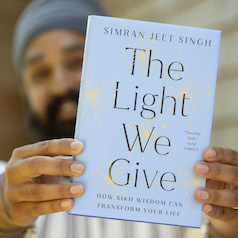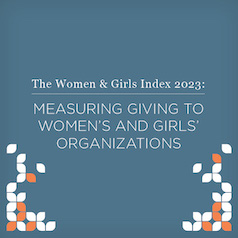Faith and Giving in Sikhism
Faith and Giving in Sikhism
In this issue of Insights, we’ve invited Dr. Simran Jeet Singh to reflect on questions of faith and giving through the lens of his Sikh tradition. We are excited to share that Dr. Singh will be our Distinguished Visitor Speaker on December 6 – be sure to keep reading to the end of the newsletter to register to attend!
Interview with Dr. Simran Jeet Singh
The subtitle of your memoir, The Light We Give, is How Sikh Wisdom Can Transform Your Life. Here at Lake Institute on Faith & Giving, we are especially interested in how faith shapes and even transforms one special part of life—giving.
What would you want us to know about the relationship between faith and giving in Sikhism?
There’s so much to say! Here’s one note. We learn through Sikh wisdom that generosity doesn’t just benefit the receiver. When approached with the right spirit, generosity can benefit the giver, too. Giving can help us decenter our own egocentrism, giving us more humility, more perspective, and ultimately, more happiness. This is what we mean when we say that it’s better to give than to receive: The world benefits, and so do we.
Are there core Sikh practices or teachings related to financial giving?
There’s an early account of our founder, Guru Nanak, that comes to mind. He meets a wealthy merchant who stashes away all his riches. Guru Nanak gives him a needle and asks him to hold on to it for the next life. The merchant laughs and asks how that would be possible. Guru Nanak then asks what the point is of hoarding wealth.
It’s a simple story, but it brings home a powerful lesson. We’re so tempted to accumulate as much as we can, and we justify it in so many ways. It’s for our comfort, or it’s a buffer, or it’s for future generations. All of that can be true – and yet, if we’re ultimately not using our wealth for good, then perhaps we’re deceiving ourselves.
Are there specific Sikh practices or principles that have been especially helpful to you in thinking about your own giving? How about in your fundraising for causes you care about?
Yes, so many. There’s a line in our daily prayers that talks about the generosity of the Creator. “The Divine keeps giving and giving; we take and take until we’re tired of it.” It’s such an interesting insight into human behavior. We are constantly consuming, worried about our own nourishment, yet somehow, we are never fully satiated. Perhaps the answer is not to consume more, but instead to consider a different kind of nourishment, one that gives us more satisfaction. I go back to this insight often, especially when I get caught up in our cultural outlooks of scarcity and competition. It reminds me that there are different approaches that could offer us different outcomes than the ones we see around us daily.
If you were to teach a course on “Fundraising from a Sikh Perspective,” what is one text or saying you would be sure to include?
I’m a longtime admirer of Shel Silverstein’s picture book, The Giving Tree. And while my views on it have evolved over the years, I still find it a wonderful text that sparks rich discussions. There’s so much to explore within it, and it often reminds me of a line from Sikh scripture that I try to keep in mind: “People keep on asking for more, and the Giver just keeps on giving.” It’s a touching reminder to me of how generosity is infinite, and that while we can always keep finding ways to give, we might also find new ways to appreciate the gifts we have been given.
What is the highest form of giving in Sikhism? Or is that the wrong way to think about it?
In my reading of Sikh wisdom, the most beautiful form of giving is one that is motivated out of selfless love. I’m not seeking to gain anything by serving you. I am serving you because I love you. Sikh wisdom teaches us that it’s possible to do this, not just for people we know intimately, but even for people we don’t know and might never meet. We call this “seva,” and it’s one of my favorite teachings in Sikh philosophy.
What’s equally important, though, is that one achieves the ideal form of seva through practicing service; one doesn’t just meditate and suddenly become adept at selfless service. The practice itself shapes you and molds you; the more one practices with intention and purpose, the closer they will come to realizing the most beautiful, selfless forms of seva.
Why is practice, rather than belief, so important to wisdom, in your view?
There’s a saying in our tradition: “Truth is high, but higher still is truthful living.” It’s a reflection on the difference between ideas and practices. The idea is important, but it means nothing if we don’t bring it into our lives. We can believe anything. We can say anything. But until we embody those values, they’re nothing more than empty words.
In 2020 you were recognized by Time as one of sixteen people fighting for a more equal America. Clearly you are a serious person. And yet you also are a funny person. Your book is full of humor, even in recounting very hard moments growing up Sikh in this country. Why is humor important to you?
First, thanks for saying I’m funny. I can’t wait to tell my wife. Second, I see humor as an important element of joy. It’s a way to appreciate the gifts we’ve been given, to notice the world around us, to take the world seriously without taking ourselves too seriously. I think I first started engaging humor as a coping mechanism, as a way to deal with the racism we encountered growing up in Texas. Over time, though, I see it less as a means of survival and more a vehicle for personal and social happiness, a practice to remember that as challenging as life may be, there’s so much to be grateful for and so much light for us all to enjoy.
Why did you decide to write your life story now?
As I traveled around the country and met people from all backgrounds, I began to see a shared challenge. So many of us were angry and frustrated with the world, and rightfully so. There was so much to be outraged about. At the same time, I noticed that we didn’t seem to have healthy ways to deal with our anger. We were getting bitter and nasty, and beginning to lose hope.
I looked back at the lessons I learned: both as a turban-wearing Sikh who faced bigotry growing up in this country, and also as someone who found ways through those challenges through the well of Sikh wisdom. I was convinced that I had a unique story to tell and hopeful that sharing what I’d learned might serve others who were desperately looking for answers. I’m so touched to see how well it’s been received and that it has helped people from all backgrounds find more calm and peace in their lives.
Simran Jeet Singh, Ph.D., is the Executive Director of the Religion & Society Program at the Aspen Institute and the author of the national bestseller The Light We Give: How Sikh Wisdom Can Transform Your Life (Riverhead, Penguin Random House).
Simran’s thought leadership on bias, empathy, wisdom, and justice extends across corporate, educational, and government settings. He is an Atlantic Fellow for Racial Equity with Columbia University and the Nelson Mandela Foundation, and a Soros Equality Fellow with the Open Society Foundations. In 2020, TIME Magazine recognized him as one of sixteen people fighting for a more equal America.
Simran earned graduate degrees from Harvard University and Columbia University, and he writes regularly for major outlets, including Harvard Business Review, TIME Magazine, and Religion News Service. Simran also authored the award-winning children’s book Fauja Singh Keeps Going: The True Story of the Oldest Person to Ever Run a Marathon (Kokila, Penguin Random House).
Born and raised in San Antonio, Texas, Simran now lives in New York City with his wife and two daughters, where he enjoys running, writing, and chasing his kids.
To learn more about Simran and his work, visit simranjeetsingh.org.
Questions for Reflection
-
- How is your own understanding of faith and giving similar to/different from the understanding offered by Simran Singh?
- If you were to teach a course on faith and fundraising, what core text would you include?
Expanded Perspective: The Light We Give
 In a 2022 column for Next Big Idea Club, Simran Singh shared five insights from his book, The Light We Give: How Sikh Wisdom Can Transform Your Life.
In a 2022 column for Next Big Idea Club, Simran Singh shared five insights from his book, The Light We Give: How Sikh Wisdom Can Transform Your Life.
1. We’re all searching for happiness.
In many ways, my life is very typical. I grew up in south Texas with three brothers and played sports all the time. Now I live in New York City, where I’m raising two daughters with my wife. Like a good American, I eat much more than I probably should, but at the same time, I recognize that my life is not typical because I wear a turban, have brown skin, and a beard. In this country, my experience has been that this makes me an enemy in the eyes of many neighbors. It has been challenging to make sense of this gap between how I see myself as a regular person trying to find happiness for myself and my family, and other people’s assumptions that I am violent, misogynistic, or backwards.
I want to share what I’ve learned since my childhood in Texas to my life in New York City, as I have tried figuring out how to navigate some core challenges that we all face. How do you deal with people’s hate without becoming hateful? How do you deal with the negativity of our world without getting sucked into it? And how can we find the middle path between disparate beliefs, so that we gain new understandings of finding the happiness we all want?
2. Much of Western philosophy is premised on the individual self.
Descartes said, “I think, therefore I am.” This is a self-centered way of understanding our world, and contributes to the American focus on hyper-individualism. This vision is at odds with many spiritual traditions. Buddhism focuses not on independence, but interdependence. Native American indigenous traditions call for a recognition of a shared collective spirit. My faith, Sikh, teaches that the ego is the root cause of human suffering.
One Sikh teaching is that the ego is like a thorn in your foot. The more you walk without removing it, the deeper it gets embedded and the more pain you must endure. Perhaps if we introspect for a moment, we might see that self-centeredness in this country is at the core of our social and political challenges. The promise of drawing from various wells of spiritual wisdom is recognizing that there are other ways of seeing ourselves and the world around us, and that we have an opportunity of following a middle path.
Sikh wisdom offers a foundational premise called Ik Onkar, which teaches that all of existence is interconnected. Oneness is the first teaching we learn as Sikhs. It’s the first term in our scripture, the first concept my parents learned growing up in Punjab, and it’s the first concept my brothers and I learned as kids in Texas. Now it’s the first concept I am teaching my daughters here in New York City. Ik Onkar is the idea that we all share the same light. There’s a divine spark in each of us, and this light binds us together. When we all have the same light, then there’s no room for discrimination or social hierarchies. There’s no place to say that someone is better or worse, evil or sacred, pure or polluted.
It completely changes the way that one views the world in relation to the self. Many traditions refer to this through the metaphor of light and I like that this reminds me of the sun. The sun is always shining, but our ability to see it depends on our vantage point. The challenge is adjusting our perspective to see the light that resides within each and every one of us.
3. Interconnectedness can be felt.
Once we see the connections, then we begin to feel them. This state of feeling is more than observation or knowledge. It’s the experience of connection, which we’ve all felt before: love. Whether with our parents, partners, children, or friends, we’ve all experienced love. We all know that love, as an experience, is an emotional connection.
The challenge is that love is fleeting and transient. But Sikh wisdom offers a deeper kind of love, because if we learn to feel the world as interconnected, then we can find a love that is more sustaining, nourishing, and which goes beyond specific relationships. Such love permeates our entire experience of this world.
This is the goal of life in Sikh philosophy. Guru Arjan, the fifth teacher, said, “I don’t want power. I don’t want Mukti. I don’t care about salvation either. All I really want is to be in love.” We achieve this goal the same way we achieve anything and that’s by practicing daily. Practice love daily and you’ll find that the ends are the same as the means. The goal is the process.
4. Love inspires action.
When love is drawn from a sense of interconnectedness, we are driven beyond action for a particular person, but rather towards action for everyone. It’s natural and selfless. In the Sikh tradition, we call this Sewa and it is central to our way of life.
Sewa is a natural expression of love and gratitude because when you truly feel connected to the people around you, and truly feel love for them, then you will do everything in your power to help them and reduce their suffering. This is my experience as a father, where if my girls are sick and unable to sleep, I will stay up with them. My wife will stay up with them too, ensuring that they’re as comfortable as they can be, even to our own detriment. We all do this for the people we love. There’s no agenda. There’s no expectation. It’s just love.
This is the most beautiful of human expressions, and we see it often in our closest relationships. In rare moments, we have seen people go beyond their interpersonal relationships, giving of themselves to people they don’t even know. Think about the sacrifices of some of the greatest people in history. Working for people beyond themselves were people like Rosa Parks and Dr. Martin Luther King Jr., and Nelson Mandela. They model for us something we are all capable of.
5. Remove the ego from activism.
The other piece of Sewa is that this approach offers a different model for activism than what we see in Western modalities. In the west, we often talk about justice as activism. It’s about action. But Sewa says it’s not just about what you do, but also what’s in your heart when you do it. Sewa is not measured by outputs, though those are important for driving positive change. Sewa is measured by the sincerity in one’s heart. Much of American activism is rooted in ego, and it’s why we’ve fallen into the traps of performing outrage online and announcing to people that we have the “right” opinions. Some call this signaling, and it’s why we post memes and black squares on Instagram without being moved into action. Our behavior doesn’t change unless our hearts change.
Sewa is different because it calls on us to approach the work with humility and selflessness. It’s not about me—it’s about love, oneness, and service. This spirit of Sewa is the antidote to egocentric American practices. It is a practice that helps reduce our egos and tap into the light that binds us together, Ik Onkar, and the love we all share, which is at the height of human experience.
A Conversation with Simran Jeet Singh
 How does generosity and religious diversity help create a healthy civil society?
How does generosity and religious diversity help create a healthy civil society?
Learn more at A Conversation with Simran Jeet Singh on Wednesday, December 6 at 6:00 pm ET in the Frank and Katrina Basile Theater at the Indiana Historical Society.
Simran is the Executive Director of the Religion & Society Program at the Aspen Institute and author of the bestselling book, The Light We Give.
Women & Girls Index
 Giving to women’s and girls’ organizations represents 1.8 percent of charitable giving in the U.S. The latest Women & Girls Index report provides a comprehensive look at charitable giving to women’s and girls’ organizations during the pandemic.
Giving to women’s and girls’ organizations represents 1.8 percent of charitable giving in the U.S. The latest Women & Girls Index report provides a comprehensive look at charitable giving to women’s and girls’ organizations during the pandemic.
As the COVID-19 pandemic disrupted services and programs that support women and girls all over the world, women’s and girls’ organizations in the U.S. received $8.8 billion in charitable giving in 2020—a 9.2% increase over 2019, according to new research released today by the Women’s Philanthropy Institute at the Indiana University Lilly Family School of Philanthropy. The fifth annual Women & Girls Index (WGI) finds that while giving to women and girls grew during the peak of the global health crisis, philanthropic support for these organizations was still lower than the 11.3% growth in overall charitable giving in 2020*, and represents less than 2% of all giving in the U.S. that year.
Subscribe
Insights is a bi-weekly e-newsletter for the religious community and fundraisers of faith-based organizations that provides:
- Reflections on important developments in the field of faith and giving
- Recommended books, studies and articles
- Upcoming Lake Institute events


